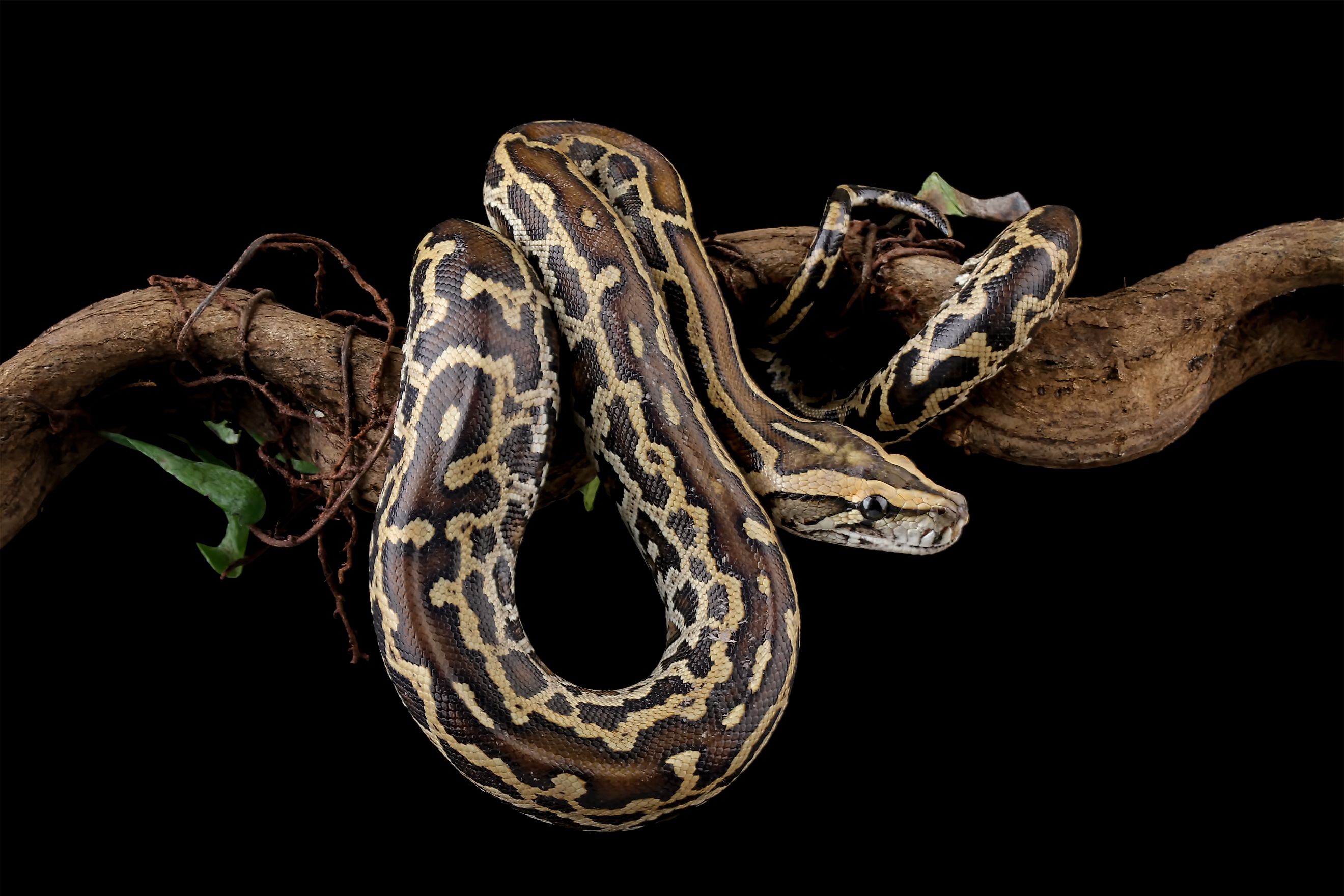
10 Biggest Snakes in the United States
The United States is something of an enigma when it comes to snakes. On the one hand, given its size and diversity of habitats, America is naturally home to a wide variety of everyone's favorite limbless, cold-blooded reptiles. At the same time, because of the cultural emphasis on freedom and consumerism, the exotic pet industry has reigned supreme for decades (it still does, but now with some limitations), particularly in states such as Texas and Florida. This has led to many large, non-native snakes establishing themselves stateside. The most notorious example of this is the rampant outbreak of Burmese pythons in the Everglades. So, which are the biggest snakes in the United States? Well, that depends on the criteria. Let's explore the various correct answers with all the necessary qualifiers.
1. Reticulated Python: Non-Native (Isolated)
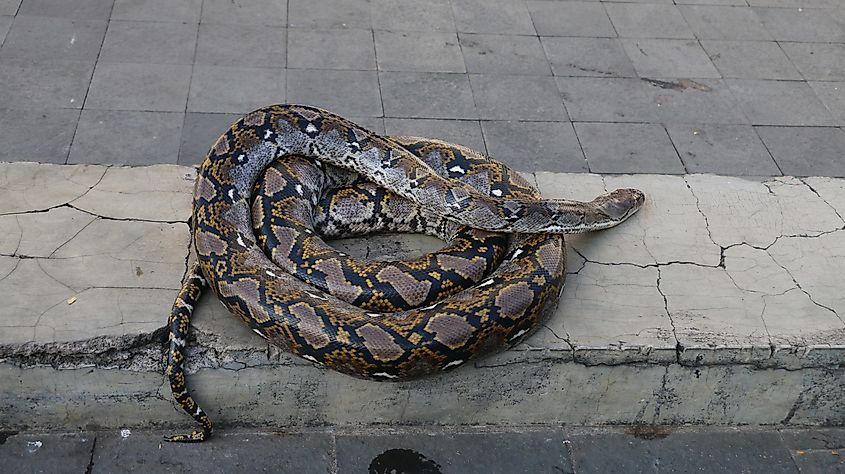
The record for the longest snake ever documented belongs to a 32-foot reticulated python (Python reticulatus). Native to Southeast Asia, from India to the Philippines, this species hasn’t established a breeding presence in any American environment. However, escaped or intentionally released pets are occasionally spotted in Florida—most frequently in the southeast regions, though they’ve been seen as far north as Largo. If you're venturing through The Sunshine State, keep an eye out for this impressive constrictor, which averages 13 to 16 feet in length. Its body features dark, intricate geometric patterns on a light yellow or brown base, making it quite distinctive. Thankfully, this snake is non-venomous so you don’t need to be too scared if you spot one.
2. Green Anaconda: Invasive & Possibly Established
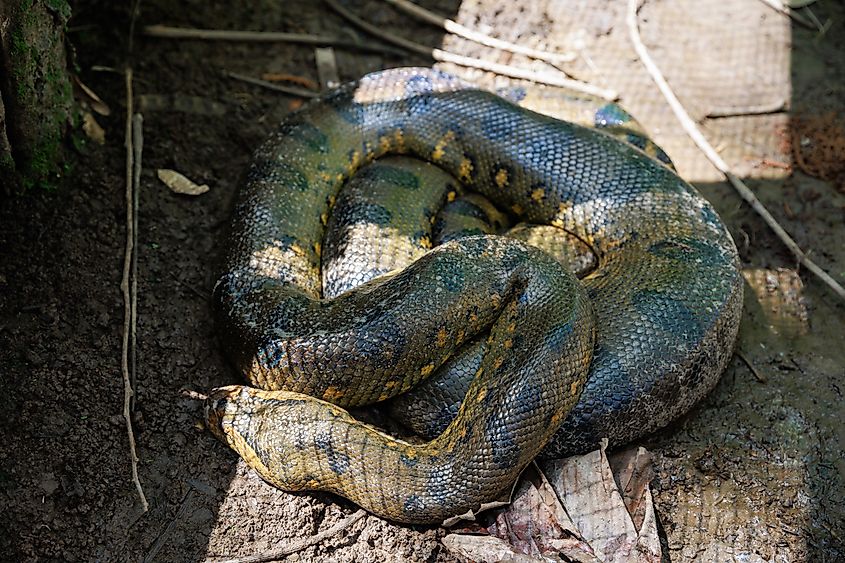
Another enormous, non-venomous constrictor snake that may have actually established a breeding population in the Florida Everglades is the infamous anaconda. Both green and yellow anacondas have been sighted, but members of the former species (Eunectes murinus), specifically the breeding females, are the ones that grow to epic proportions. While the reticulated python has been documented to grow slightly longer, the green anaconda is the largest snake on the planet in terms of mass. In fact, scientists recently discovered a new species, the northern green anaconda (Eunectes akayima). The viral National Geographic footage showed a submerged female well in excess of 20 feet and estimated to weigh over 440 pounds. That said, the average female green anaconda reaches lengths of up to 17 feet while males are smaller reaching an average of just 10 feet long. Only relatively small anacondas have been captured in the Everglades, but again, given the vast amount of dense, undeveloped territory, it is hard to say for sure what's out there.
3. Burmese Python: Invasive & Established
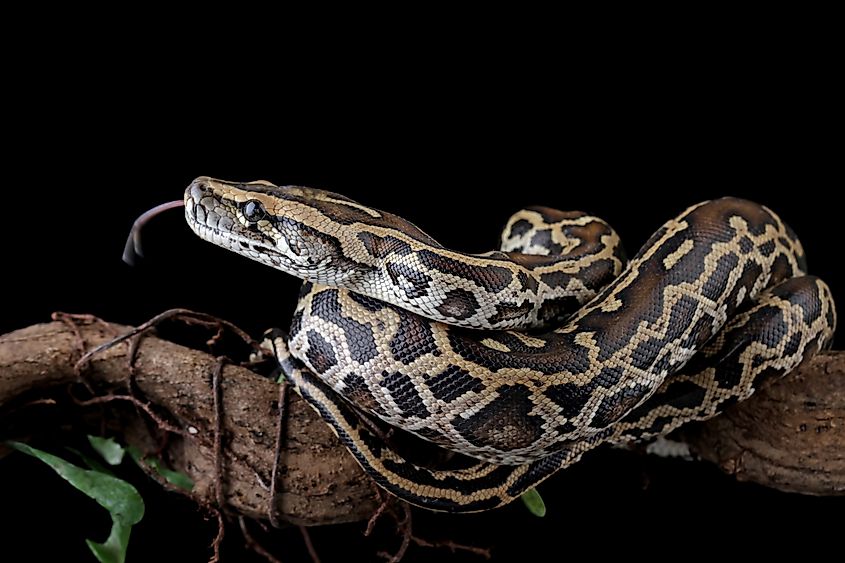
Though the green anaconda situation may still be manageable, the Burmese python (Python molurus bivittatus) invasion is firmly out of control. The first wild specimen was discovered in the Florida Everglades back in 1979. Since then, due to a combination of abandoned or escaped pets, a local breeding facility being compromised by 1992's Hurricane Andrew, and this hefty snake's ability to thrive in the subtropical wilderness, the Florida Fish and Wildlife Conservation Commission (FWC) now estimates that there could be anywhere from 100,000 to 300,000 pythons in and around the Everglades. Such an explosion of apex predators has decimated small mammal populations and put exceptional pressure on the Everglades' native predators, such as alligators and the elusive panther. The largest specimens thus far caught in southern Florida have measured between 17-18 feet and weighed nearly 200 pounds, but this species has been known to grow as long as 23 feet.
4. Boa Constrictor: Non-Native (Isolated)
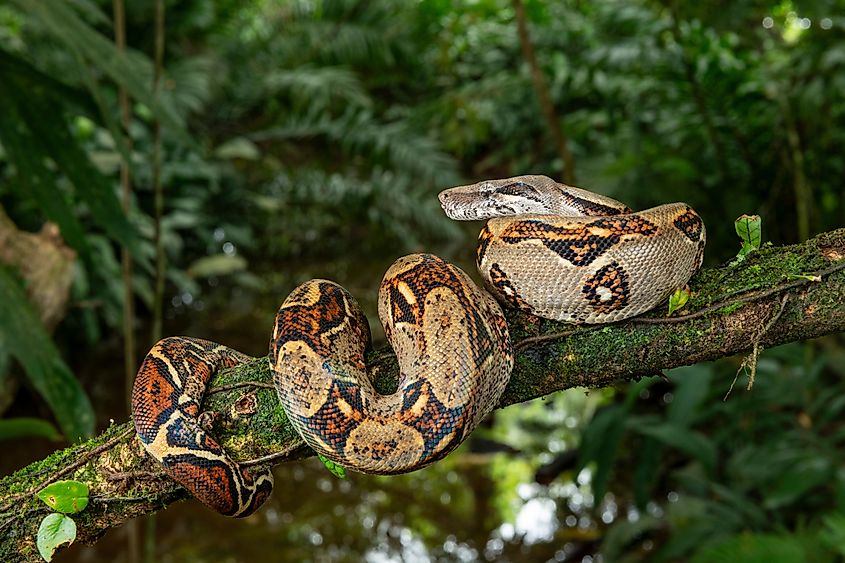
The boa constrictor (Boa constrictor), primarily found in Central and South America, has also made its presence felt in Florida. While typically reaching lengths between 10 and 16 feet, the 11-foot-long red-tailed boa, a popular exotic pet, is among the most commonly sighted. In the wilds of Florida, these snakes have adapted to a variety of habitats, from dense forests to suburban areas. Larger boas prefer staying grounded, while smaller ones often climb trees. Nocturnal by nature, they spend daylight hours concealed, only emerging at night to hunt. Despite being isolated, their presence highlights the ongoing issue of exotic pets impacting local ecosystems.
5. African Rock Python: Non-Native (Isolated)
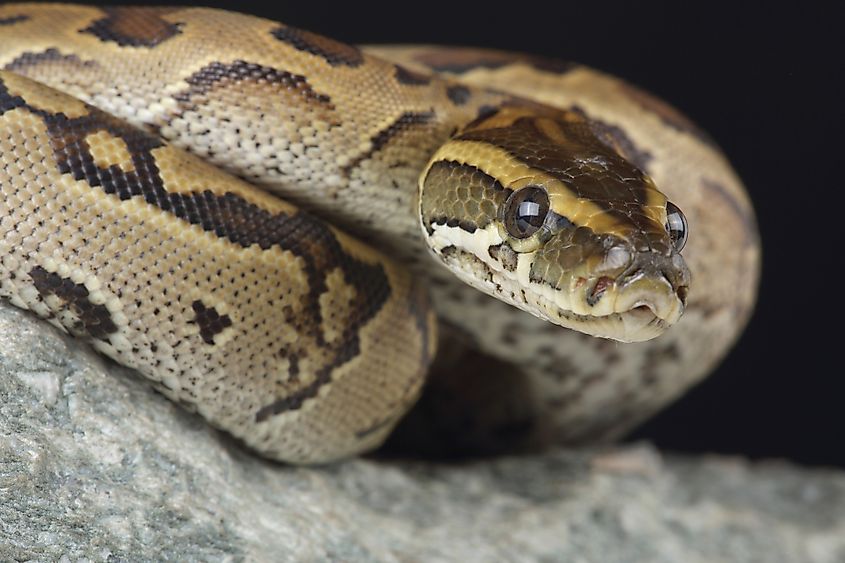
The lengthy African rock python (Python sebae) is the largest snake species in sub-Saharan Africa, averaging 10-to-16-foot-long. In the United States, this non-venomous snake has been captured in the counties of Sarasota and Miami-Dade. A small wild population has been confirmed in a localized area of Miami, but for the most part, its presence in the United States is strictly a product of the pet trade. According to the Florida Museum, this species can be distinguished by the two dark and irregular, but otherwise congruous, blotch patterns (framed by black and white borders) that line its tan-brown or brownish-gray back. African rock pythons like to hide themselves in dense vegetation and use heat-sensing facial pits to detect prey in the dead of night. In terms of weight, these snakes are on the lighter end of this list, with an average weight of around 120 pounds
6. Eastern Indigo Snake: Native
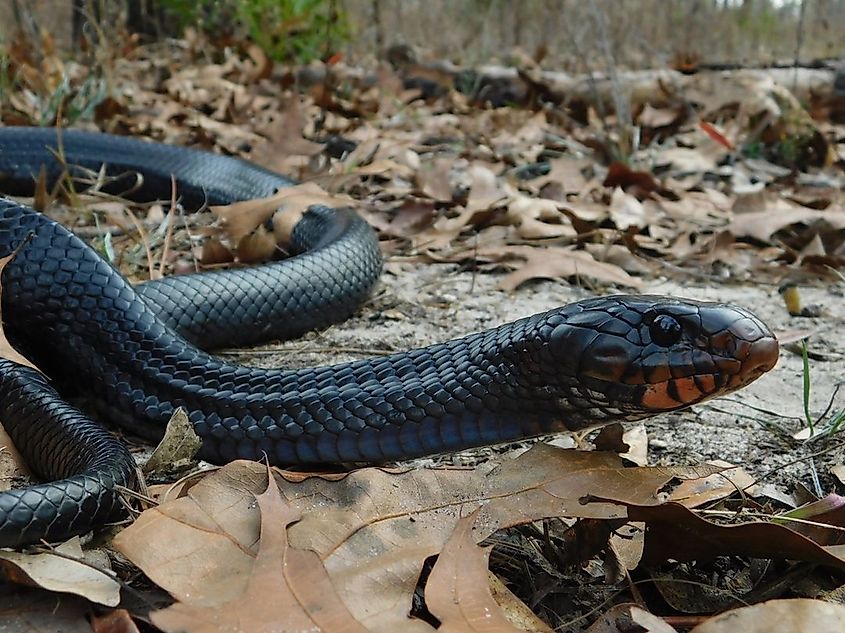
The eastern indigo snake (Drymarchon couperi) is the largest native non-venomous snake in the United States, typically growing between five and seven feet. However, some reach up to nine feet. This glossy black snake, found in the southeastern U.S., including Florida, Georgia, Alabama, and parts of Mississippi, plays a crucial role in its ecosystem. The eastern indigo snake, often seen in gopher tortoise burrows, is an important predator, helping maintain a balanced ecosystem by controlling populations of smaller animals. Despite facing challenges due to habitat loss, over-collection for the pet trade, and hunting, conservation efforts have helped stabilize its population. Thankfully, habitat restoration, reintroduction programs, and other targeted initiatives have boosted the eastern indigo snake's conservation status up to Least Concern.
7. Eastern Diamondback Rattlesnake: Native
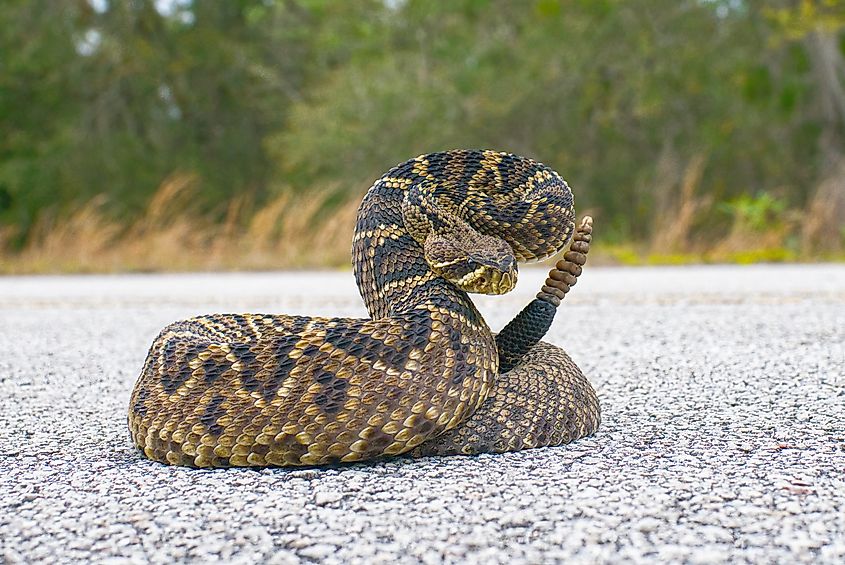
The eastern diamondback rattlesnake (Crotalus adamanteus) is the longest and heaviest venomous snake in not only the United States but all of North America. This noisy pit viper typically grows between three to six feet in length but can reach up to eight feet and weigh over 10 pounds. Like many of its rattlesnake relatives, the eastern diamondback has a stout body and broad head. True to its name, its back is adorned with distinctive diamond patterns. This snake can strike up to two-thirds of its body length, but it primarily uses this ability to hunt small mammals (they are proficient exterminators) and birds. If you're walking off the beaten path in the southeastern United States, where this snake is endemic, and its population is healthy, listen carefully for the iconic rattle—a clear warning to keep your distance.
8. Eastern Rat Snake: Native
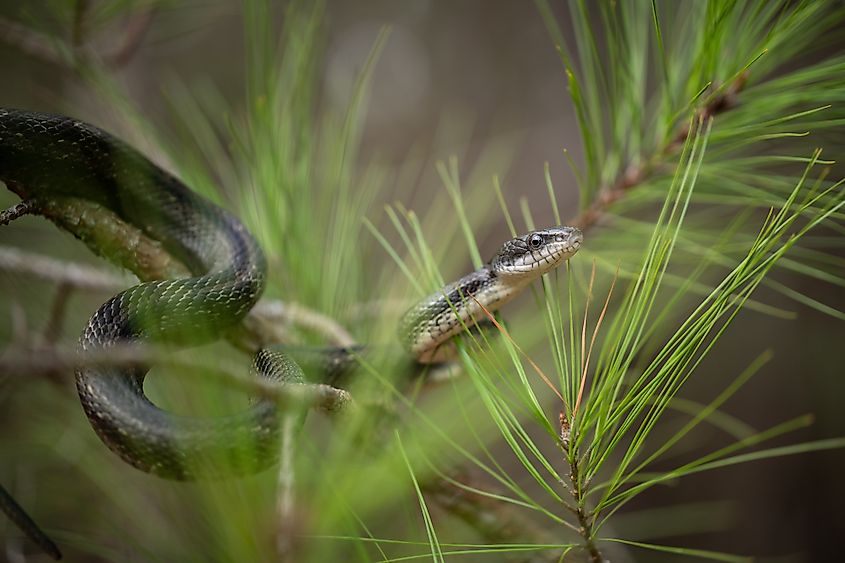
The eastern rat snake (Pantherophis alleghaniensis) is a large, non-venomous snake commonly found across the eastern United States. Ranging in length from 3.5 to 7 feet, this adaptable species varies in coloration depending on its habitat, with some individuals displaying gray, yellow, or orange hues with dark blotches and stripes. Eastern rat snakes are skilled climbers and can be found in a variety of environments, from forests and farmlands to suburban areas. Their diet primarily consists of rodents, making them beneficial for controlling pest populations. Despite their intimidating size, eastern rat snakes are generally harmless to humans.
9. Eastern Coachwhip: Native
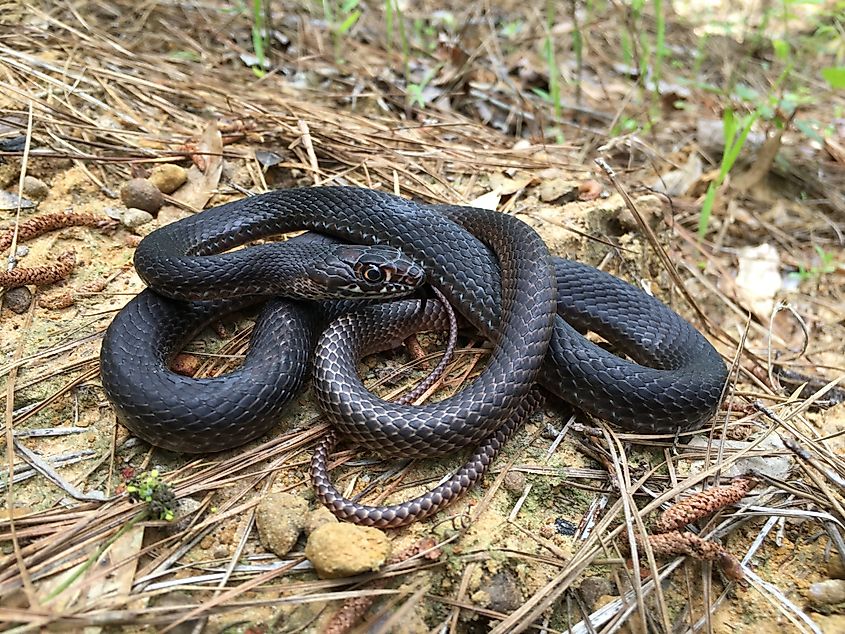
Eastern coachwhips (Masticophis flagellum flagellum) are slender serpents, with most measuring between 42-60 inches. But, certain individuals will exceed this range by another foot. According to the Florida Museum, the longest eastern coachwhip on record stretched to a remarkable 102 inches (8.5 feet). Aside from its proportions, this non-venomous species, which roams coast-coast-coast in the southern United States (as well as northern Mexico), is most easily recognized by its dark brown or black head and light-tan back half. Though this is often the case, some coachwhips are uniformly-colored.
10. Bull Snake: Native
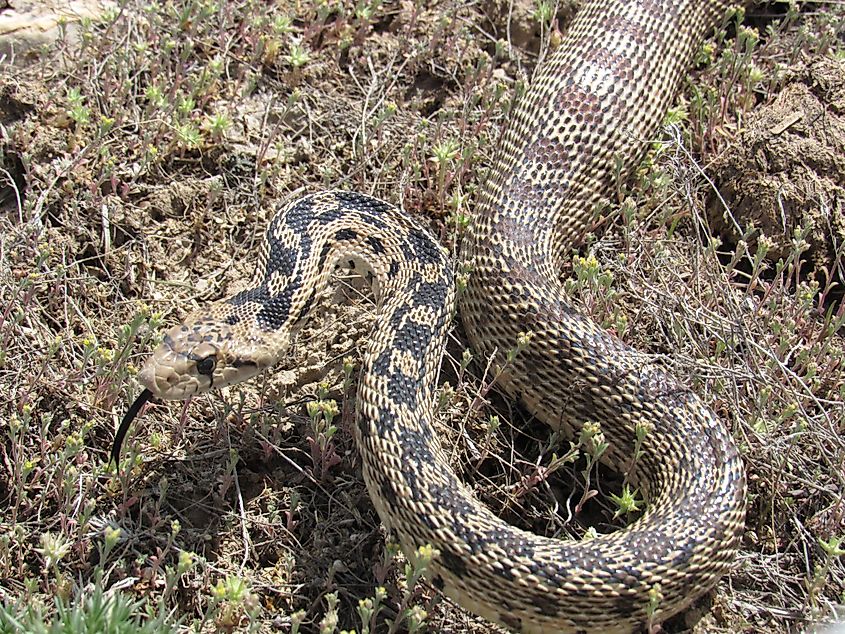
The heavy-bodied bull snake (Pituophis catenifer sayi) ranges in length from 37 to 72 inches. Typically, these snakes are yellow with a dense mix of brown, black, white, or occasionally reddish blotching. Bull snakes are well-known for their ability to imitate rattlesnakes, despite being non-venomous, by coiling up and shaking their raised tails. These inquisitive reptiles are commonly found across much of Texas and extend throughout the western, southern, and southeastern United States. If you're driving through these regions, be mindful as bull snakes, despite living up to 22 years in captivity, are often killed while crossing or basking on roadways.
Parting Thoughts
The United States is home to a fascinating array of giant snakes, both native and non-native, that captivate herpetologists and nature enthusiasts alike. From the dense swamps of Florida to the arid deserts of Texas, the sheer variety of these impressive reptiles is a testament to the country’s diverse habitats. While some of the largest species are indigenous and play crucial roles in their ecosystems, others have been introduced through the exotic pet trade, adding a complex layer to the local wildlife dynamics. In exploring these giants, we uncover not only their impressive sizes but also their significant impact on the environments they inhabit.











